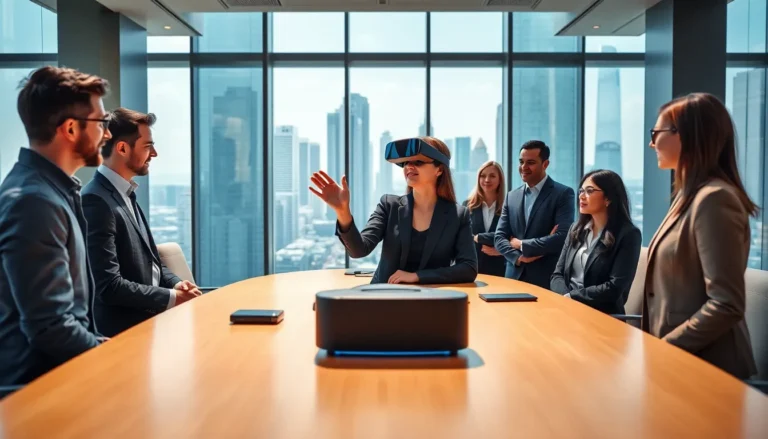Imagine a world where doctors don’t just rely on traditional imagery but can literally overlay digital information on a patient’s body. Sound like science fiction? Welcome to the exciting realm of augmented reality (AR) in healthcare. This cutting-edge technology is not only revolutionizing the way medical professionals diagnose and treat patients, but it’s also turning everyday procedures into high-tech, engaging experiences. Let’s jump into how AR is reshaping healthcare, one pixel at a time.
Table of Contents
ToggleOverview of Augmented Reality in Healthcare

Augmented reality, often confused with virtual reality, is like the cool cousin of the tech world. While virtual reality immerses users in a digitally created environment, augmented reality enhances the real world by layering digital elements onto it. In healthcare, this means that surgeons can view critical patient data while operating, or physicians can visualize complex anatomical structures during consultations.
This technology combines computer-generated visuals with real-world views, significantly aiding professionals from diagnostics to surgical procedures. From its early beginnings as a concept, AR has evolved, gaining traction in medical schools, hospitals, and even patient homes. With its ability to transform complex data into usable insights, it represents a significant leap forward in medical technologies.
Benefits of Augmented Reality in Medical Practice
The adoption of AR in healthcare comes with a treasure trove of benefits. Here are some standout advantages:
- Enhanced Visualization: Surgeons can access 3D models of organs, allowing for precise navigation during complex operations. This visual guide can be a game-changer in reducing risks associated with surgical procedures.
- Improved Training: Medical students and residents benefit immensely. With AR, they can practice procedures in a simulated environment, gaining hands-on experience without the stakes of real-life surgeries.
- Patient Engagement: For patients, understanding their conditions can sometimes feel like decoding a foreign language. AR can help visualize explanations, making it easier for patients to grasp their health issues and treatments.
- Remote Assistance: Specialists can remotely guide surgeons during challenging operations via AR, creating an interactive environment where guidance flows freely.
On a broader scale, AR can lead to cost-efficiency in medical practices, eventually benefiting healthcare systems and patients alike.
Applications of Augmented Reality in Healthcare
The applications of augmented reality in healthcare are as diverse as they are promising. Here’s a look at some of the most remarkable uses:
Surgical Assistance
During surgeries, AR can display vital information like patient vitals directly on the surgeon’s field of view. This means surgeons can work more efficiently without needing to divert their attention to monitors.
Medical Training
AR applications allow medical students to practice procedures interactively. For instance, they can learn anatomy by overlaying images on a human body model and seeing how systems interact in real-time.
Patient Treatment Plans
In rehabilitation, AR can offer personalized exercise regimes overlaid onto a patient’s visual field. This tailored approach keeps patients engaged and motivated as they recover.
Emergency Situations
In acute care scenarios, AR can guide paramedics through trauma care in the heat of the moment, displaying crucial steps and protocols to follow in real-time.
Challenges and Limitations of Augmented Reality in Healthcare
While augmented reality has transformative potential, it doesn’t come without challenges. Some significant limitations include:
- Technological Hurdles: Developing and maintaining AR systems require substantial investment and continuous updates to remain functional and effective.
- Interoperability Issues: Different healthcare systems use various technologies. Ensuring that AR integrates smoothly with existing devices and software can be a challenging job.
- User Adoption: Medical professionals often face a learning curve. Training staff to use new technologies competently can slow down the implementation process.
- Regulatory Constraints: Healthcare regulations vary widely. Navigating this landscape while ensuring compliance adds another layer of complexity to AR solutions.
Understanding these challenges is crucial for stakeholders aiming to leverage AR effectively in their practice.
Future Trends of Augmented Reality in Healthcare
Looking ahead, the future of augmented reality in healthcare is bright and boundless. Here are some trends expected to shape its evolution:
Increased Use of AI Integration
Expect AR to blend more seamlessly with artificial intelligence. This combination could lead to predictive analytics, where the system anticipates surgical procedures based on patient data and enhances real-time assistance.
Wider Adoption in Telemedicine
As telemedicine continues to rise, AR might play a key role in creating immersive consultation experiences that help bridge gaps between patients and healthcare providers.
Enhanced Personalization
Customization will rise, allowing for tailored experiences based on individual patient preferences and needs. Patients may receive health information unique to their conditions, continuously enhancing engagement and adherence.






